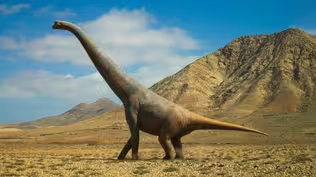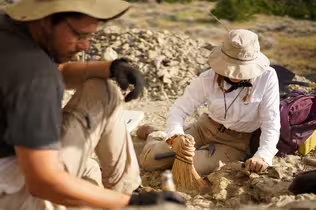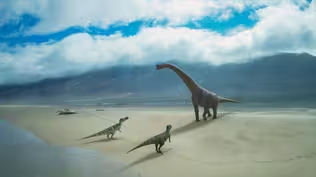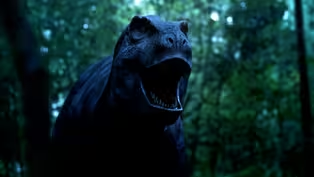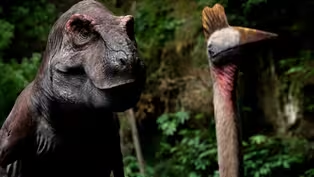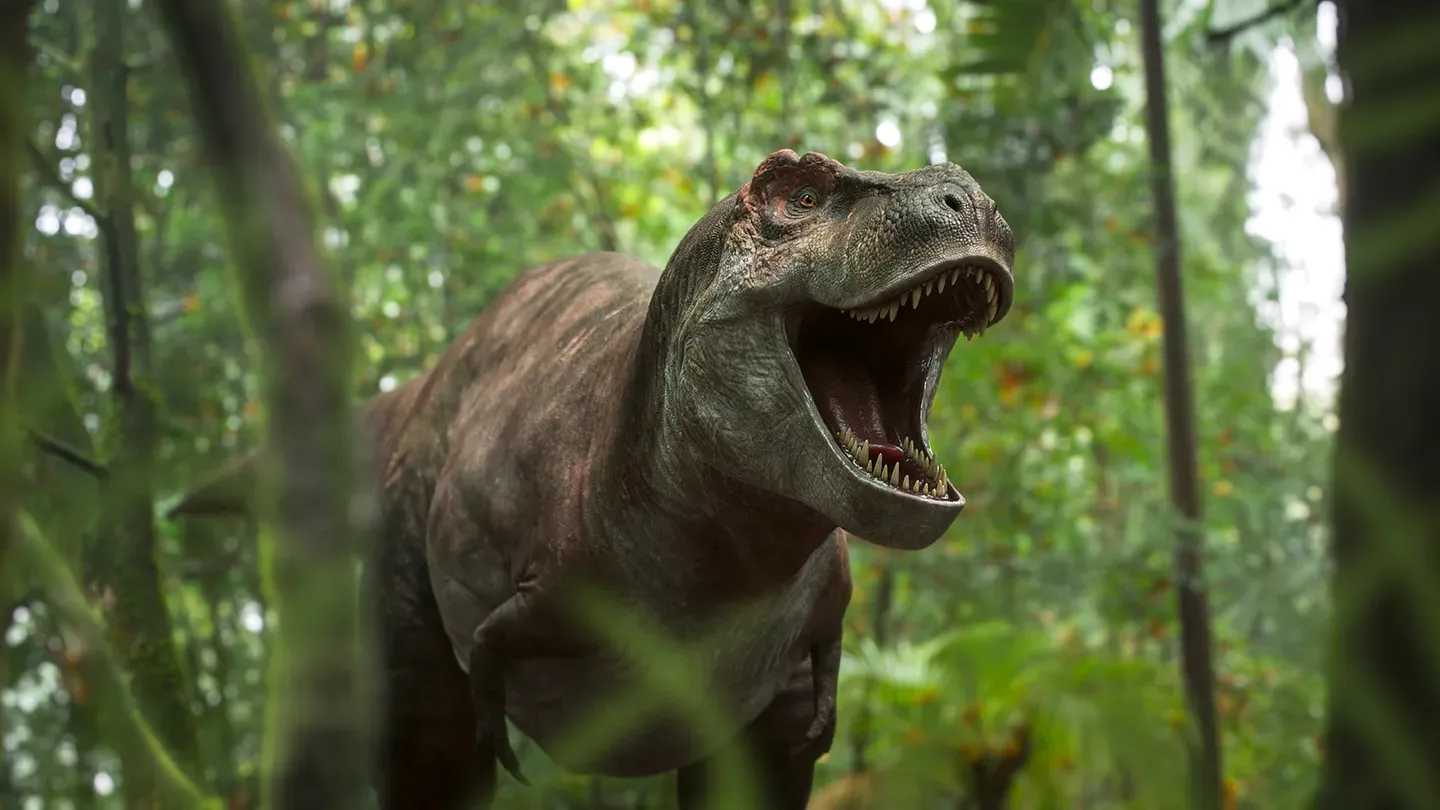

The Orphan
Episode 1 | 54m 1sVideo has Audio Description, Closed Captions
An orphaned baby Triceratops must outwit a deadly T. Rex. Can she survive?
An orphaned baby Triceratops must outwit a deadly T. Rex. Today, paleontologists are uncovering her remains and use stunning VFX to bring her story vividly to life.
See all videos with Audio DescriptionADProblems playing video? | Closed Captioning Feedback
Problems playing video? | Closed Captioning Feedback

The Orphan
Episode 1 | 54m 1sVideo has Audio Description, Closed Captions
An orphaned baby Triceratops must outwit a deadly T. Rex. Today, paleontologists are uncovering her remains and use stunning VFX to bring her story vividly to life.
See all videos with Audio DescriptionADProblems playing video? | Closed Captioning Feedback
How to Watch Walking with Dinosaurs
Walking with Dinosaurs is available to stream on pbs.org and the free PBS App, available on iPhone, Apple TV, Android TV, Android smartphones, Amazon Fire TV, Amazon Fire Tablet, Roku, Samsung Smart TV, and Vizio.
Providing Support for PBS.org
Learn Moreabout PBS online sponsorship♪ Bertie Carvel, voiceover: Over 66 million years ago... ♪ [Deep, guttural growl] our world... [Dinosaur screeches] was ruled... [Dinosaur growls] by dinosaurs.
[Dinosaur bellow] [Growling] The largest animals that have ever walked the earth.
[Growling] ♪ Today, dinosaur experts across the globe are uncovering the bones they left behind.
♪ Allowing us to imagine how these extraordinary creatures may have lived... ♪ so that we can tell their story... ♪ [Dinosaur shrieks] and they... [Squealing] can walk again.
[Growls and grunts] ♪ ♪ Eastern Montana... ♪ a vast, untamed wilderness... ♪ with extraordinary stories to tell.
♪ This is dinosaur country.
♪ [Hammer tapping] ♪ Here, a team from the North Carolina Museum of Natural Sciences is excavating an iconic species-- a Triceratops... Oh, sweet.
Carvel, voiceover: but this is no ancient giant.
It's really small, very young individual.
Nicky: Got a nice baby drake, a phenomenal find.
Carvel, voiceover: The team calls her Clover.
♪ Studying her bones, we can begin to imagine her world... ♪ and tell her story for the first time.
♪ At the end of the Cretaceous, North America is a vast expanse of green.
♪ Where Montana is today, there is a lush landscape of sprawling subtropical forests, crisscrossed by waterways.
♪ This is Laramidia... ♪ home to prehistoric giants... [Pounding footsteps] and the occasional... ♪ not-so-giant.
♪ [Soft, nasal honk] Meet Clover, the Triceratops.
♪ Less than two feet tall, she's tiny.
♪ [Clover whimpers] [Snorts] [Whimpers] ♪ Despite her size, Clover roams the jungle alone.
♪ [Clover whimpering] ♪ These strange white objects mean one thing-- ♪ playtime... ♪ but curiosity can be a dangerous thing... ♪ [Croaking] when you're living in a land of monsters.
♪ [Metallic tapping] ♪ Clover is rare.
[Tapping continues] The vast majority of Triceratops fossils discovered are from adults.
♪ Clover's remains are a chance to uncover the story of a youngster.
♪ a once-in-a-lifetime opportunity for dig leader and expert in horned dinosaurs Eric Lund.
Check out these teeth.
Oh, wow.
Carvel, voiceover: Clover's tiny jaw bone has been painstakingly restored by fossil preparator Nicky Simon.
Isn't she gorgeous?
She is gorgeous.
It's beautiful.
Don't often find upper jaws this complete, let alone with all the teeth in them, no wear on them.
Carvel, voiceover: The teeth's edges, for slicing through plant material, are still razor sharp.
Check them out.
Sure.
Oh, yeah.
♪ Carvel, voiceover: These have been barely been used.
They almost look carnivorous.
Carvel, voiceover: The teeth are a clue to Clover's young age.
Look how small this upper arm bone is.
Yeah?
Let's see.
Carvel, voiceover: By measuring Clover's arm bone... Little over a foot.
About 34 centimeters.
Carvel, voiceover: they can more accurately estimate how old she was.
She must have only been about 3 years old.
Which means she was just a baby.
♪ Carvel, voiceover: A baby buried all alone.
♪ Seems to be by herself, haven't found any adult bones in this quarry.
Without the herd, without her mother, very vulnerable.
♪ Carvel, voiceover: We'll never know why Clover was alone.
♪ What we do know is that in the late Cretaceous, young solitary dinosaurs don't last long.
♪ [Wings flap] ♪ [Hiss] [Hiss] [Hiss] [Growling] An Infernodrakon, a giant Pterosaur common at the end of the Cretaceous.
With a 16-foot wingspan, it tries to intimidate Clover... [Hissing] and then there's the razor-sharp beak.
♪ but Clover is nimble... ♪ [Growls] [Hiss] ♪ Carvel, voiceover: and this mother just wants her egg back.
♪ This time, the little Triceratops was lucky... ♪ but danger lurks everywhere... [Deep, guttural growl] and it gets much, much bigger.
♪ A mile from Clover's dig site, more fossilized remains are emerging.
[Tapping] ♪ So we got a bone over here that's very thin, very slender, very long.
♪ This looks like one of the processes off of the tail vertebrae, and it helps lock the tail into a much more rigid structure.
♪ Carvel, voiceover: These thin bones may once have formed part of a thick, muscular tail 20 feet long... ♪ but this was no Triceratops.
Lund: This is sort of a meat-eating dinosaur feature.
[Tapping] [Metallic scraping] Carvel, voiceover: Palaeontologist Elis Mulready holds the final clue.
♪ It's a little bit beat up.
♪ It's really thick tooth designed for crushing bones.
And it's got those kind of drawn-together serrations.
You can still feel them.
I would love to meet the creature who had this tooth, but it'd be a bit scary.
Yeah.
Ha ha!
[Tapping] [Scaping] ♪ Carvel, voiceover: It's a tooth that can only belong to one animal.
[Rumbling growl] [Heavy footsteps] ♪ [Growling] ♪ Standing 13 feet tall... ♪ and weighing in at almost 9 tonnes-- ♪ Tyrannosaurus Rex.
♪ With 5-feet-long jaws, the Earth's most infamous apex predator could swallow Clover whole.
♪ Fortunately, the hunter's focus is elsewhere.
[Birds chirping] ♪ Padded feet act like shock absorbers, keeping its approach quiet.
♪ [Grunts] [Growling] ♪ For T. Rex, a light snack... [Growls] [Huffing] ♪ for Clover, a terrifying first encounter... ♪ and it won't be her last.
♪ Up to 20,000 T. rex roam Laramidia.
♪ To survive, Clover needs protection... ♪ and fast.
♪ Lund: Ready?
Man: Ready.
Carvel, voiceover: In the search for more clues Eric and evolutionary ecologist John Kanipe are heading deeper into the wilderness.
♪ Lund: So you asked me about snakes earlier.
Kanipe: Oh, yeah.
There's just a baby rattler in the bottom there.
♪ Carvel, voiceover: They want to understand who was sharing the forest with Clover.
Kanipe: Alright.
I'm ready when you are.
♪ Carvel, voiceover: It's obvious from the evidence on the ground... Lund: A bit of bone here coming out.
Carvel, voiceover: That Clover's world was teaming with other dinosaurs.
Some bigger pieces, pretty busted up.
That one's got a bit more surface.
Carvel, voiceover: One familiar species is turning up more than any other.
Most of them belong to Triceratops.
Carvel, voiceover: Triceratops once dominated this area.
They've been sitting on the surface a really long time.
They're pretty weathered.
♪ Carvel, voiceover: One fossil shows why Triceratops was so successful.
♪ Lund: Looks like a big brow horn.
♪ Oh, man, it's a bit busted up.
You can still see where all the blood vessels would be, even on the horn.
Lund: Yeah.
Carvel, voiceover: This horn would have been almost 4 feet long and behind it, a bony shield over 6 feet wide.
♪ Here was a creature seemingly custom built for fighting off large predators.
Got these big horns on the front of your face, wave them around, maybe make a T. rex think twice before attacking ya.
♪ Carvel, voiceover: Triceratops formidable defences made it one of the most successful dinosaur species of its day, meaning an adult Triceratops would be the perfect protector for Clover.
[Deep, guttural breaths] ♪ [Barks] Carvel, voiceover: This old bull will do nicely... ♪ Carvel, voiceover: but there's a problem.
♪ Who needs a troublesome youngster following you around?
♪ [Whimpers] [Growls] ♪ [Whimpers] As another day ends, Clover is still alone, and darkness is setting in.
♪ Eric thinks Clover may have had good reason to fear the nighttime most of all.
♪ Back at base camp, he uses a scan of a T. rex skull to print a 3D model of the killer's brain cavity.
[Printer whirring] ♪ This is the endocast of a T. rex.
♪ For an animal that has a head you know, several feet long, not a real big brain, a dinosaur's not doing calculus, but it was enough to do what the animal needed to do.
It was very successful.
Right, it just needs to process the information.
It's got a lot of sensory input.
Carvel, voiceover: Though small compared to a human's, this brain is fine-tuned for hunting.
We got these really big olfactory bulbs in the front.
That's for smell.
That's for smell, yeah.
Carvel, voiceover: T. rex probably had one of the most sensitive noses of any dinosaur...
It's probably picking up on minuscule parts per million.
Carvel, voiceover: and it wasn't just the killer's sense of smell that was super-charged.
Here in the middle would be the part of the brain that controls vision.
T. rex does really big eyes, just like an owl, they take in a lot of light.
Carvel, voiceover: These incredible senses likely made T. rex a lethal nocturnal hunter.
[Thunder claps] [Rain pattering] ♪ As darkness descends... ♪ it's time to begin the hunt.
♪ Locking on to a telltale scent... [Sniffing] ♪ it seems that supper is nearby.
♪ Whilst most creatures have sought safe places to sleep... ♪ Clover is awake.
She must bulk up by a tonne each year to reach full size, so feeds often through the night.
♪ In the darkness, she sees little... ♪ But T. rex sees her perfectly.
♪ [Twig snaps] ♪ Saved by her size.
♪ [Thunder roaring] ♪ [Dinosaur growls] ♪ Luck seems to be on Clover's side.
[Loud, trumpeting call] ♪ [Clover bleat] Carvel, voiceover: She survived a close encounter with T. rex... [Roar] and from the sound of things... [Loud, trumpeting call] a new ally may be close at hand.
♪ In the search for more giants, the team is putting to the test the very latest fossil-hunting techniques, a 66 million-year-old treasure hunt using 21st century technology.
If we fly out towards those Badlands that would be a great spot.
[Beeps] Man: The gyro's stabilize.
Carvel, voiceover: Eric's teamed up with palaeontologists Thomas Kay...
Going for arm.
[Drone beeps] Carvel, voiceover: And Dr. Michael Pittman.
Kay: Ready to launch.
[Drone whirring] ♪ Carvel, voiceover: Their prototype laser drone scans the ground with UV light, searching for the telltale glow of minerals within ancient fossils... ♪ to create a treasure map of prehistoric remains.
♪ See, here, we've got some specs maybe the size of a tennis ball, interesting but, you know, we want the big stuff.
Carvel, voiceover: It's early days for the technology, and it has limitations, ♪ but one spot on the ground... Pittman: Bang, look at that.
Carvel, voiceover: is glowing brightly.
So that must be a really big piece.
Yeah.
That's big.
♪ Carvel, voiceover: As dawn breaks, Eric and Nicky head into the Badlands to see this enormous fossil.
♪ Look how big it is.
♪ Carvel, voiceover: It's the lower leg bone of a truly colossal dinosaur.
Lund: Seems to have been sitting out on the surface for quite some time.
This is a big bone.
This animal would have been you know, maybe around 20, 24 feet long.
Carvel, voiceover: But this is no Triceratops.
It's not a T. rex, either.
[Loud, trumpeting call] Echoing through towering trees... [Loud, trumpeting call] ♪ the calls of perhaps the strangest dinosaurs who roam here-- [Sniffing] ♪ [Loud wail] Edmontosaurs... ♪ herd animals known as the cows of the Cretaceous.
♪ Weighing over 6 tonnes, these social creatures tolerate Clover.
♪ As a fellow plant eater, she's no threat to them.
♪ [Whines] ♪ The herd could give Clover the protection she needs... ♪ and it's not just safety they offer.
[Nasal bellowing] A playmate.
♪ In amongst these giants... ♪ [Clover yawns] Clover can begin to feel safe... [Snoring] ♪ but danger is never far away.
♪ [Scraping] [Tapping] 66 million years ago, T. rex ruled over these lands, the apex predator for over two million years.
As it rolls over, just get your hands under it.
Carvel, voiceover: The team wants to discover how this fearsome hunter took down its prey.
♪ Inside this protective plaster coat is the predator's leg bone.
Eric thinks there might be more underneath.
1, 2, 3.
Carvel, voiceover: Protruding from the rock... That's a bone.
Carvel, voiceover: one of the giant's vertebrae.
Beautiful preservation.
It was a big, big animal.
Carvel, voiceover: It allows Eric to estimate more accurately T. rex's full size.
On the order of 30 feet maybe more, 10 meters, something like that.
♪ Carvel, voiceover: They wrap their discoveries in a protective plaster jacket.
♪ It's just a tiny fraction of T. rex's skeleton, but it's enormous.
♪ This jacket's probably about 150 kilograms, 200, 300 pounds.
♪ It's just so huge.
Carvel, voiceover: Alive, adult T. rex weighed over 8 tonnes, but this enormous weight may actually have been a hindrance.
Certainly not the 40-mile-an-hour Jeep-chasing animal at Jurassic Park.
Their physiology just wouldn't allow them to run that fast.
Probably speed walker.
Carvel, voiceover: T. rex probably couldn't run for fear of breaking its own legs, with a top speed of just 15 or 20 miles an hour... ♪ not exactly slow, but a fast human could outsprint one.
I think he could.
I think I'm gonna take a sharp turn, it's gonna have a hard time following me.
You think we only just gotta be faster than him.
Maybe I'm a little overconfident.
♪ [Birds chirping] ♪ Carvel, voiceover: So adult T. rex weren't sprinting after their prey.
♪ This killer relied on another tactic-- ♪ the element of surprise.
As Clover and the Edmontosaurs sleep soundly... ♪ T. rex approaches slowly from downwind... ♪ [Snoring] [Growling] ♪ but it's not easy being stealthy... [Twig snaps] when you're the size of a bus.
♪ [Barks] ♪ [Wailing] ♪ The Edmontosaurs form a defensive line... ♪ rearing up on their hind legs to appear as big as possible... ♪ but holding your nerve isn't easy... [Growling and wailing] ♪ and it only takes one of the herd to panic.
♪ [Squeals] [Crunching] ♪ A lucky escape for Clover, not for her new friend.
[Whimpers] ♪ With the adult Edmontosaurs on the move... ♪ Clover is alone once more.
♪ Survival was a game of chance in the late Cretaceous, and the odds were stacked against young dinosaurs like Clover.
♪ The team has tracked down a remarkable fossil with a chilling tale to tell.
Like the weirdest baby bundle ever.
Carvel, voiceover: It may look like a nondescript lump of rock but it's shape and texture tell the experts this is a coprolite, fossilized feces.
Eric works with fossil restorer Aubrey Knowles... 67 1/2 centimeters, or 26.5 inches.
Carvel, voiceover: to examine this prehistoric poo.
-That's a massive turd.
-That's a really big turd.
Ha ha ha!
Carvel, voiceover: Most coprolites can't be attributed to any specific species, but bone fragments within the dino dung reveal this was the waste product of a meat eater... ♪ and then there's the matter of size.
So we're at 15.7 centimeters across, or 6.2 inches.
That's a wide cloaca.
That is a very wide butthole.
Ha ha!
The only large-bodied, carnivorous dinosaur that could have possibly dropped this would be a T. rex, so very, very cool.
Carvel, voiceover: It's an astonishing fossil, the excrement of the most notorious predator in history.
It's interesting how many bones there are preserved in the dropping.
Carvel, voiceover: By examining coprolites, it's even possible to identify the killer's victims.
♪ T. rex feces have been found to contain bones that are small and smooth... Lund: That speaks to a more juvenile or young prey.
Carvel, voiceover: the bones of babies.
Baby dinosaurs would be very vulnerable.
Bite size.
Energy is precious, go after easy prey.
♪ Carvel, voiceover: Needing a quarter of a tonne of meat a week to sustain their enormous bulk, baby dinosaurs like Clover were a common meal for T. rex.
♪ Nothing is off the menu.
♪ [Insects chirping] ♪ Naive, defenceless, and small enough to swallow whole, Clover would make an excellent snack.
♪ [Squeals] ♪ [Huffing] ♪ With nowhere to hide, it's a good time to bump into an old acquaintance.
♪ [Roaring] [Roaring] ♪ Few creatures can challenge T. rex, but a full grown Triceratops might be the only animal that doesn't need to turn and run.
♪ Who wins in a fight, Triceratops or T. rex?
♪ The two giants were locked in an evolutionary arms race, adapted to battle each other, but Eric thinks Triceratops may have had a surprising trump card.
♪ This fossilized fragment was once part of the huge frill extending from the back of the skull, but it wasn't solid bone.
♪ Lund: All these vascular channels on the surface, all these pits and grooves that are in it go all over the surface of the frill.
This surface was covered in a lot of blood vessels.
Carvel, voiceover: The blood flow suggests to Eric a Triceratops frill was more than just a shield.
♪ The idea is, they could change the color pattern of their frill, flash these different colors.
Pushing all this blood up into its frill, this would be a great way to send a message.
It would have been really intimidating.
♪ [Growling] ♪ Carvel, voiceover: The giants are evenly matched.
[Growls and grunts] [Roaring] ♪ Each weighs over 8 tonnes... ♪ each with fearsome weaponry... ♪ but Triceratops plays his trump card.
♪ Flushing blood into his frill creates huge, colorful eye spots.
♪ They make Triceratops seem even bigger... [Growls and hissing] ♪ [T. rex shrieks] ♪ but T. rex isn't apex predator for nothing.
[Roars] ♪ [Growling] ♪ Stalemate... ♪ but for T. rex, there's still an easier meal close by.
♪ [Clover barks] ♪ Most young dinosaurs never made it to adulthood, and Clover was no exception... ♪ but as the dig season draws to a close... ♪ her exact cause of death is still unknown.
Lund: You know we're not sure how baby Clover died.
In digging her bones up, we haven't found any evidence of predation, there doesn't seem to be any injuries, no bite marks, things like that.
Up to this point, it remains a mystery.
Got it.
Alright.
♪ Carvel, voiceover: But we do know one thing-- if Clover had died as a meal for T. rex, there probably wouldn't be any remains at all.
♪ [Continuous trill of birds and insects] ♪ For Clover, it seems as if time has run out... ♪ but she still has one advantage-- her size.
♪ With T. rex distracted... ♪ a moment of surprise.
♪ [Gasping] ♪ Clover has survived her encounter with history's most infamous killer.
♪ For now, she's safe... ♪ [Whimpering] ♪ and while this old bull may not seek the company of a youngster... ♪ Clover's not giving up just yet.
♪ ♪ Carvel, voiceover: Few creatures spark the imagination like T. rex and Triceratops, perhaps the most iconic dinosaurs ever to have lived.
♪ They were also amongst the last to walk the Earth.
♪ Today the remains of these giants litter the ground in Eastern Montana, a playground for palaeontologists like Eric Lund, who wants to learn more about how these icons met their end.
Lund: They're the last vestiges of the dinosaur rule.
They were making a good go of it, and it just got cut short.
♪ Carvel, voiceover: It came from outer space, an asteroid the size of Mount Everest smashing into the Atlantic Ocean off Mexico... ♪ an event often thought of as wiping out the dinosaurs in an instant... [Explosion] [Screeching] but the truth isn't nearly so simple.
I'm sure some of them got obliterated, the ones very near the impact but here in Montana, we're far away from where that impact hit so they could have lasted hundreds of years after that impact.
Carvel, voiceover: So what really killed off these giants?
Lund: As we walk from the bottom of this formation to the top, we're going up through time.
There becomes a point where we sort of stop finding fragments, lose the dinosaurs.
Carvel, voiceover: This is the exact spot in the fossil record where Triceratops and T. rex die out.
♪ Eric's drafted in palaeontologist Michael Pittman to help him investigate this 66-million-year-old crime scene.
♪ Michael has built a high-powered laser that highlights different elements in rock.
Pittman: The laser's essentially giving us chemical information from the rocks that otherwise we wouldn't be able to find with existing technologies.
♪ Pittman: Goggles on.
Lund: Yep, goggles on.
♪ Carvel, voiceover: The laser scans across the surface while the camera photographs the glowing elements... ♪ Pittman: It's actually lighting up a scorpion.
Carvel, voiceover: and in just a few seconds, the image is ready.
Pittman: So this is the image that we have, and you'll see-- Notice how there's this layer.
Lund: Wow, it's cool to see.
Carvel, voiceover: This feint line is rock rich in iridium.
Lund: And iridium doesn't naturally occur often on Earth.
♪ [Asteroid explodes] Carvel, voiceover: It was in the days and weeks after the asteroid hit that the deadliest damage occurred.
♪ Several trillion tons of rock were ejected into space... ♪ rock that rained down on the land below... ♪ leaving behind a band of iridium that's now been found in over 100 different locations all around the world... ♪ proof that the asteroid's impact affected the entire planet, but Eric thinks even that wasn't the full story.
♪ Lund: A huge cloud of debris and ash would have blocked out the sun for maybe many months, maybe years, would have been like nuclear winter.
Carvel, voiceover: The loss of the sun was the real killer, a planet plunged into darkness.
Lund: You block out the sun, so you start killing off the plants, you got no plants, so you get no plant eaters because they got nothing to eat, and then the meat eaters can't survive, would have been relatively slow process.
It wasn't an instantaneous event.
Carvel, voiceover: Eventually, decades after the asteroid struck, over 75% of life on Earth was lost forever.
Including those giants of the Cretaceous-- T. rex and Triceratops.
Lund: It's possible without that asteroid impact, things could have been completely different and dinosaurs could have lived for another 180 million years.
♪ [Birds chirping] Carvel, voiceover: Next time, a deadly predator battles to keep his family alive.
♪ In one of the most dangerous places in Earth's history.
♪
Greatest Standoff: T. Rex vs Triceratops
Video has Closed Captions
Clip: Ep1 | 2m 37s | T. Rex and Triceratops face off in a brutal showdown that shakes the earth. (2m 37s)
Video has Closed Captions
Clip: Ep1 | 1m 56s | How the bulky T. Rex may have been sneakier than we once thought. (1m 56s)
Providing Support for PBS.org
Learn Moreabout PBS online sponsorshipSupport for PBS provided by:

